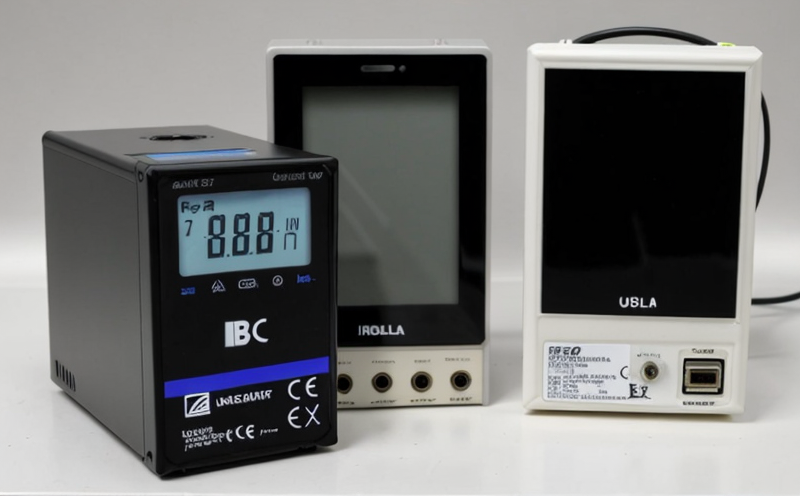IEEE 1625 Consumer Electronics Battery Testing for Portable Computers
The IEEE standard 1625-2003 is a comprehensive guide designed specifically for testing batteries used in portable computers. This standard ensures that the battery performance, safety, and reliability meet stringent industry requirements. The test procedures outlined are essential for quality managers, compliance officers, R&D engineers, and procurement personnel responsible for ensuring product integrity.
The IEEE 1625-2003 focuses on various aspects of battery testing including initial capacity, rate capability, retention, self-discharge, temperature cycling, accelerated life test (ALT), abuse testing, and safety tests. These tests are critical to ensure that the batteries perform optimally under real-world conditions.
Initial Capacity Testing is one of the first steps in this process. It measures how much charge a battery can hold when fully charged for the first time. This helps manufacturers understand the battery's efficiency from the outset. Rate Capability Testing, on the other hand, assesses how well a battery performs under different discharge rates.
Retention testing evaluates how quickly a battery loses its stored energy after being fully charged and then placed in storage conditions. Self-discharge tests measure the natural loss of charge over time. Both these tests are crucial for understanding long-term performance and shelf life.
Temperature Cycling involves subjecting batteries to rapid changes between extreme temperatures, simulating real-world usage scenarios where temperature fluctuations can significantly impact battery health. Accelerated Life Testing (ALT) uses higher than normal operating conditions to shorten the testing period, allowing engineers to predict how a product will perform over its expected lifetime.
Abuse tests push batteries beyond their normal operational limits to determine if they can withstand unexpected stress or damage without failing catastrophically. Safety tests ensure that even in adverse situations, the battery does not pose risks such as overheating or catching fire.
The IEEE 1625-2003 also specifies detailed procedures for specimen preparation and reporting requirements. Specimen preparation involves careful selection and conditioning of batteries to ensure they are representative of the production batch. Reporting must include all relevant test results along with interpretations, conclusions, and recommendations based on these tests.
The standard's rigorous approach helps manufacturers identify potential issues early in development cycles, improving product quality and reducing costly recalls later on. By adhering to IEEE 1625-2003, companies can demonstrate compliance with international standards, enhancing their reputation among consumers who value safety and reliability above all else.
Given the complexity of modern portable computers, thorough battery testing is non-negotiable. Whether you're developing new products or ensuring existing ones meet performance expectations, IEEE 1625-2003 provides a robust framework for achieving excellence in battery design and manufacturing.
Applied Standards
| Standard | Description |
|---|---|
| IEEE 1625-2003 | This standard provides comprehensive procedures for testing batteries used in portable computers, covering aspects such as initial capacity, rate capability, retention, self-discharge, temperature cycling, accelerated life test (ALT), abuse testing, and safety tests. |
| ISO/IEC 17025 | Absent from the scope of IEEE 1625-2003 but relevant for ensuring that laboratories conducting these tests are capable of producing valid test results. It sets out requirements for technical competence. |
| IEC 62687 | This standard covers additional aspects related to battery testing, particularly in relation to portable devices like laptops and smartphones. |
Why Choose This Test
The IEEE 1625-2003 test ensures that batteries used in portable computers meet the highest quality standards. By conducting thorough initial capacity, rate capability, retention, self-discharge, temperature cycling, accelerated life testing (ALT), abuse tests, and safety assessments, this standard guarantees reliable performance under various conditions.
Choosing IEEE 1625-2003 means investing in product reliability and consumer trust. It helps avoid costly issues later by identifying potential problems early during the development stage. Furthermore, compliance with international standards like IEEE 1625-2003 can enhance a company's reputation, making it more appealing to buyers who prioritize safety and durability.
Manufacturers benefit from reduced risks of product failures leading to recalls or legal actions. Consumers gain peace of mind knowing that their devices are built with safe and efficient batteries. Overall, selecting IEEE 1625-2003 ensures superior quality while fostering brand loyalty and market competitiveness.
International Acceptance and Recognition
The IEEE 1625-2003 has achieved significant international recognition due to its stringent testing procedures. This standard is widely accepted across various regions, including Europe, Asia, North America, and South America. Many countries have incorporated aspects of this standard into their national regulations for battery safety.
Companies that comply with IEEE 1625-2003 enjoy broader market access because compliance signals adherence to global best practices in electronics manufacturing. This can open doors to new markets where stringent quality controls are necessary.
The acceptance of this standard also contributes to enhanced consumer confidence, as it indicates a commitment to producing safe and reliable products. In an era where safety concerns loom large, such credentials become invaluable assets for businesses operating internationally.





